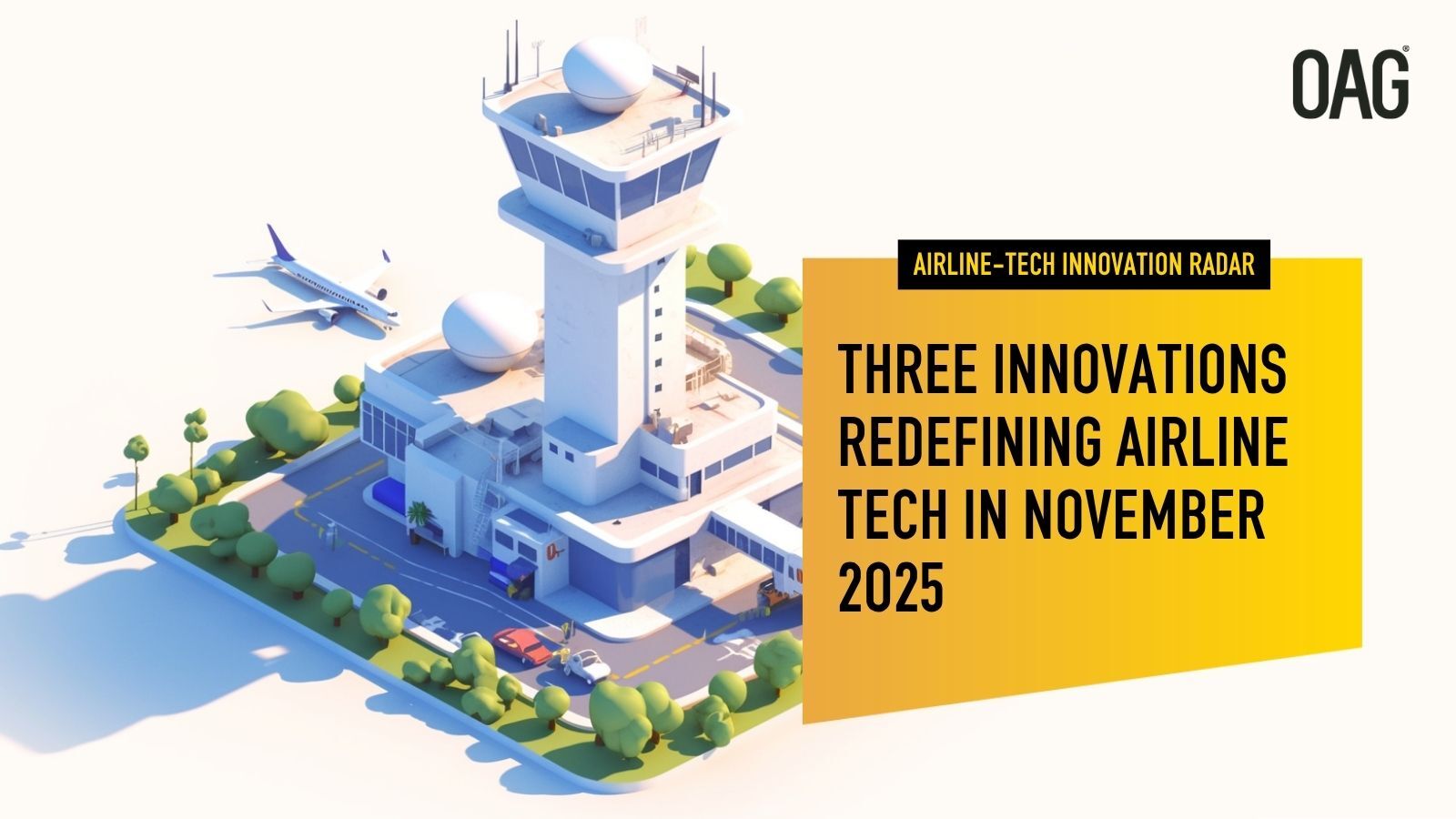In our October edition, we deliberately took a step back from the nonstop wave of AI headlines to focus on the quieter, non-AI side of aviation innovation. But, as we hinted in our closing line, it was only a matter of time before AI returned to the spotlight.
This month, it’s back, and stronger than ever. What’s most striking about the recent wave of AI announcements is the sheer range of players now involved. Airlines, airports, and OTAs are all racing to lead the movement, each trying to carve out their slice of the AI future.
A perfect example is Expedia: the company is integrating new AI tools into its own products, building APIs for partners, embedding its app within ChatGPT, and even joining forces with Perplexity on its new AI-powered browser, COMET. It’s a sign of just how far-reaching the AI transformation in travel has become.
So yes, AI is back, but not every breakthrough needs an algorithm. Here’s our must-read overview of the innovations (AI-powered and not) reshaping Airline Tech in November.
Key Summary:
- Aeroporti di Roma’s new AI Virtual Assistant aims to give travelers real-time support and personalized guidance before, during, and after the airport experience via WhatsApp and the airport’s website.
- easyJet plans to roll out the SITA Agent app, a mobile tool that gives ground staff the freedom to assist passengers anywhere in the airport terminal.
- Sabre has unveiled a significant upgrade to its continuous pricing engine, enhanced with advanced AI. This new system delivers real-time, personalised price recommendations by processing live booking data alongside wider market trends.
Innovation #1: Aeroporti di Roma Launches an AI Virtual Assistant for Smarter Traveler Support
Let’s start at the airport front. While AI-powered chatbots at airports are nothing new, Aeroporti di Roma (ADR), the operator of Rome’s Fiumicino and Ciampino airports, has taken the concept a step further.
Built in collaboration with AWS and Storm Reply, ADR’s new AI Virtual Assistant aims to give travelers real-time support and personalized guidance via WhatsApp and the airport’s website.
How does it work?
The chatbot is designed to accompany travelers throughout their entire airport journey, from planning their trip to collecting their luggage.
- It can tell you where to park before even leaving home, how to reach the terminal by bus, taxi, or train, and what restaurants or shops are worth stopping by once you’re inside.
- It also offers baggage status updates, connection assistance for those with transfers, and (crucially for a global gateway like Rome) multilingual support, making it easy for travelers from all over the world to get help in their own language.
It’s not hard to see the value in that. Most airport chatbots stop at flight updates or basic service info. ADR’s version feels closer to a true digital companion, one that stays relevant before, during, and after the airport experience.
Why does this innovation matter?
Two things make this initiative stand out.
First, the integration of parking and transportation information gives ADR something most airports lack: a pre-journey touchpoint. The ability to connect with travelers before they enter the airport environment could open a whole new layer of engagement.
Second, the multilingual design shows a smart understanding of Rome’s unique position as a major European hub welcoming nearly 50 million travelers annually. For an airport serving such a diverse mix of nationalities, accessibility isn’t just nice to have; it’s essential.
The real test, however, will be adoption.
Historically, passengers have viewed airlines or booking platforms as their primary source of travel updates, rather than airports. If Aeroporti di Roma can change that perception, it could redefine how airports engage with passengers and prove that travelers are (finally) ready to chat with the airport itself.

Innovation #2: SITA and EasyJet Free the Ground Crew from the Desk
We’re staying on airport ground for our second innovation, but this time, we’re switching perspectives. And no, it’s not AI-powered. It’s powered by people, mobility, and a clever rethink of how ground operations actually work.
- Over the past 12 months, SITA and easyJet have been quietly testing a new way of working at Gatwick Airport and four other UK hubs.
- Their joint project is the SITA Agent app: a mobile tool that gives ground staff the freedom to assist passengers anywhere in the terminal.
During the year-long trial, over 1,000 ground crew members used the app to print more than 40,000 boarding passes, check in 30,000 passengers, and board over five million travelers, all without being tied to a traditional check-in counter.
The trial was such a success that easyJet now plans to roll it out to more than 150 airports across its European network.
So, what’s so special about this?
At first glance, it might sound like a simple digital upgrade: a mobile app for ground crew. But the real innovation lies in what this represents: a shift from fixed to flexible airport operations.
- For decades, airport workflows have revolved around static infrastructure like desks, kiosks, and long queues that bottleneck the entire system, especially during peak travel seasons when terminal space is tight.
- The SITA-easyJet model flips that logic. By equipping staff with mobile tools connected to check-in, boarding, and bag-tagging systems, they can go where passengers need them most (in the queue, at the gate, or anywhere on the floor).
It’s the aviation equivalent of what Apple did for retail when it got rid of the checkout counter.
- Store employees suddenly became free to help customers throughout the space, answering questions, processing payments, and creating a more human, less transactional experience.
- SITA and easyJet are doing the same for airports: transforming the passenger journey from a queue-based process into a conversation-based one.
And just like in retail, the impact could scale fast. By reducing reliance on fixed counters, airlines and airports can make far better use of terminal space, speed up turnaround times, and deliver more personalized service at peak times, all without major structural overhauls.
If this experiment is any indication, the future of airport operations could be a lot more mobile and actually a lot more human, rather than automated by machines.

Innovation #3: Sabre Supercharges Airline Pricing with Real-Time AI
From the airport floor to the airline’s commercial command centers, where fares are set and revenue decisions are made, our final innovation takes us deep into the world of airline pricing.
Sabre made headlines this month with a major update to its continuous pricing engine, now supercharged by advanced AI integrations. The system promises to deliver real-time, passenger-level price recommendations by combining live booking data with signals from broader market dynamics and demand trends.
How does it work?
- Sabre’s AI engine continuously monitors what travelers are searching and booking, adjusting fare levels in real time.
- Instead of relying on static fare classes or pre-defined price ladders, it generates dynamic, data-driven price points that reflect true market demand at any given moment.
- The system analyzes live bookings, competitor pricing, and seasonal demand shifts to ensure that every fare offer is as responsive (and profitable) as possible.
In fairness, Sabre isn’t alone in this race.
Nearly every major airline and technology provider is working to make pricing more continuous, flexible, and intelligent – a topic we explored in detail in our Continuous Pricing Primer. A growing ecosystem of players, including Fetcherr, PROS, FLYR, Amadeus, Accelya, Sabre, and many others are all pushing AI deeper into the core of airline revenue management. The recent announcement from Sabre serves as one clear example of how this shift is taking shape in practice. According to the company, early adopters of its AI-enhanced pricing engine have reported revenue uplifts between 3% and 6% in competitive markets, achieved by matching fares more precisely to demand and customer segments in real time.
Why does this matter?
On a macro level, it’s another clear sign that fare pricing is evolving fast. The industry’s decades-old model of rigid fare classes is giving way to a new era of data-driven retailing, where AI turns static price tags into fluid, adaptive offers.
This evolution is being accelerated by the rise of Shopping Data – a concept we at OAG define as the growing pool of real-time traveler search and shopping signals. As airlines begin to harness this data more effectively, it becomes a powerful input for pricing engines like Sabre’s, helping match fare offers to market intent with unprecedented precision.
If Rome’s airport app and easyJet’s mobile ground operations point to new ways of running the airline experience, Sabre’s AI engine shows how the next generation of intelligence is being built right into the industry’s financial core.

That’s it for November. See you again in December for our yearly closeout on the innovations shaping aviation and Airline Tech in 2025.




